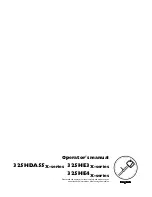
InstructIon booklet
InstructIon booklet
InstructIon booklet
InstructIon booklet
5
causes and operator preVentIon from kIckback
FURTHER SAFETY INSTRUCTIONS FOR ALL SAWS - Kickback causes and related warnings
Causes and operator prevention of kickback:
•
Kickback is a sudden reaction to a pinched, bound or misaligned saw blade, causing an uncontrolled saw to lift up
and out of the workpiece toward the operator;
•
When the blade is pinched or bound tightly by the kerf closing down, the blade stalls and the motor reaction drives
the unit rapidly back toward the operator;
•
If the blade becomes twisted or misaligned in the cut, the teeth at the back edge of the blade can dig into the top
surface of the wood causing the blade to climb out of the kerf and jump back toward the operator. Kickback is the
result of saw misuse and/or incorrect operating procedures or conditions and can be avoided by taking proper
precautions as given below.
1.
Maintain a firm grip with both hands on the saw and position your arms to resist kickback forces. Position
your body to either side of the blade, but not in line with the blade. Kickback could cause the saw to jump
backwards, but kickback forces can be controlled by the operator, if proper precautions are taken.
2.
When a blade is binding, or when interrupting a cut for any reason, release the trigger and hold the saw
motionless in the material until the blade comes to a complete stop. Never attempt to remove the saw from
the work or pull the saw backward while the blade is in motion or kickback may occur. Investigate and take
corrective action to eliminate the cause of blade binding.
3.
When restarting a saw in the workpiece, centre the saw blade in the kerf and check that saw teeth are
not engaged in the material. If the saw blade is binding, it may or kickback from the workpiece as the saw is
restarted.
4.
Support large panels to minimise the risk of blade pinching and kickback. Large panels tend to sag under
their own weight. Supports must be placed under the panel on both sides, near the line of cut and near the
edge of the panel.
5.
Do not use dull or damaged blades. Unsharpened or improperly set blades produce narrow kerf causing
excessive friction, blade binding and kickback.
6.
Use extra caution when making a “plunge cut” into existing walls or other blind areas. The protruding blade
may cut objects that can cause kickback.
7.
When restarting a cut that has already been started ensure you are in the middle of the kerf and the blade can spin
freely
8.
Always support both sides of the job, if the job bends towards the saw under its own weight it will jam.
9.
Always know what is behind the area you are cutting as you may come in contact with something on the other side.
10. Most importantly, use common sense, if you feel you shouldn’t be using it the way you are or if you are unsure of
what you are doing then don’t do it. Please call or email the Swarts Tools support team and we can clarify.
Содержание SW1075
Страница 2: ......
Страница 14: ......
Страница 15: ......
Страница 16: ...please read care and safety instructions before use please read care and safety instructions before use...


































